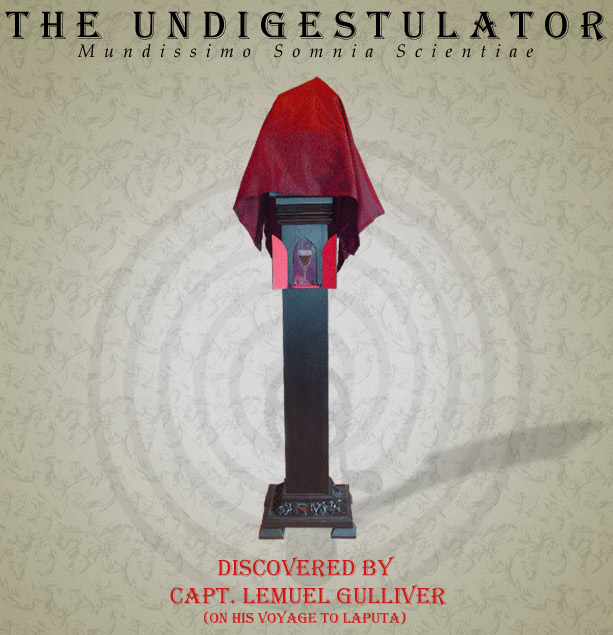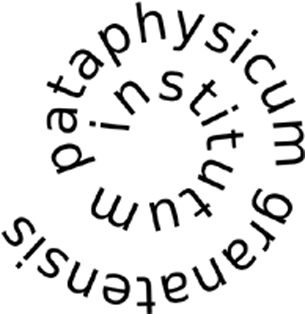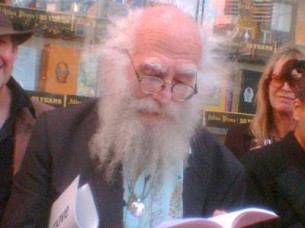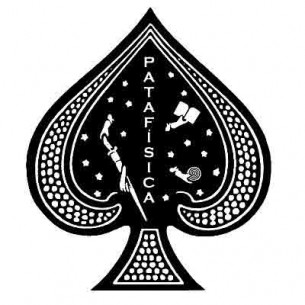From the ufficial site of the Musée Patamécanique we can read: “Located in Bristol, Rhode Island, le Musée Patamécanique sees itself as part of the culture of the Wunderkammer – or the Cabinets of Curiosities and is rumored to open its doors to friends, colleagues and the occasional curiosity seeker.“
We have found this interesting article by Greg Cook from boston.com
Next stop Wonderland
BRISTOL, R.I. — Neil Salley stands in the foyer of the Musée Patamécanique, his curious art institution secreted away on a grand 19th-century estate. The walls of the tiny room are filled with antique-looking prints of museums, tacked-up butterflies, a rat trap, a magnifying glass, and a photo of Cinderella’s castle at Disneyland
Salley offers a visitor a shot of sherry and a toast, then launches into a history of museums and pataphysics, a term coined by French writer Alfred Jarry that, Salley later notes, “is the science of imaginary solutions. It is the underpinnings of our entire society. All words being equal, you can come up with any definition of it you like.”
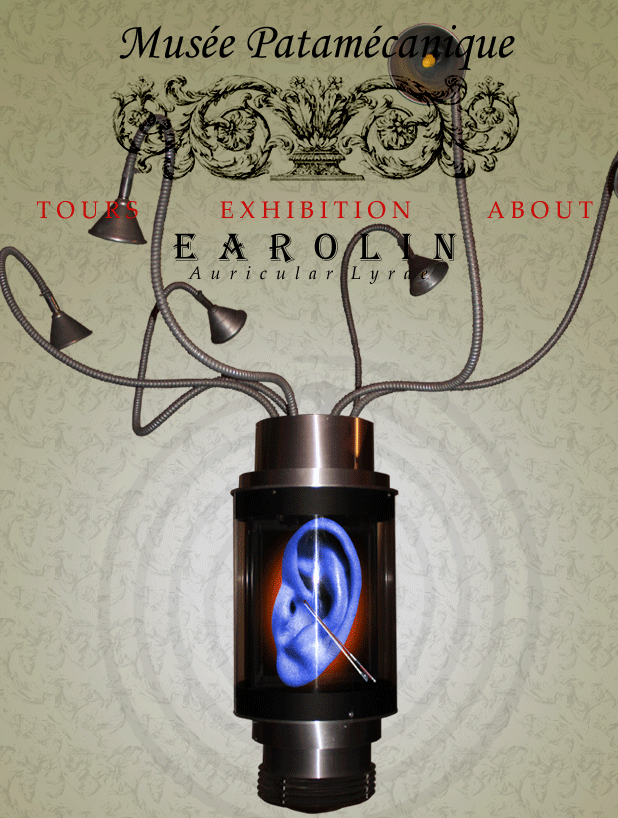 |
 |
 |
All this is a prelude to entering the next room, Patamechanics Hall, a dark gallery of mechanical oddities designed to spark pataphysical thinking that seem teleported straight from the 19th century. The “Pharus Foetidus Viscera,” or “Olfactory Lighthouse,” is a cylindrical pedestal topped by a bell jar and surrounded by metal octopus arms. Inside the jar, something Salley describes as a unicorn horn slowly rotates, causing it to secrete green goop that resembles shampoo gel. Put your nose to the metal arms and, he says, you’ll smell pomegranate, melon, citrus, Christmas tree, sugar cookie. The “Auricular-lyrae,” or “Earolin,” is another cylindrical stand with a glass chamber on top housing a floating apparition of a giant ear stroked by a violin bow, as music plays.
Salley, who appears to be in his early 40s but declines to say his age, keeps up a steady stream of patter. Garbed in a sport coat, bowtie, and porkpie hat, he seems part gentlemanly absent-minded professor, part crackpot inventor, part Mad Hatter. “If you do concur with the notion that we are what we pretend,” Salley says, “then what must naturally follow is: so is everything else.”
The more you listen to Salley and experience his wondrous contraptions, the more you lose your bearings between reality and fantasy. The Musée Patamécanique turns out to be an intellectual hall of mirrors. It is a museum for questioning museums, and art, and science, and officialdom, and facts, and the world.
Cabinets of wonder
Salley says he studied art and communications at Emerson College, directed television commercials for a decade, then earned a master’s degree in digital media at Providence’s Rhode Island School of Design in 2006. There he began creating the performances and mechanical sculptures (with computer components) that became prototypes for his work in the Musée. About 750 to 1,000 visitors have come since he opened the institution last September. Western museums trace their roots to 16th-century European wonder cabinets, dazzling collections assembled by aristocrats of natural and man-made curiosities. Wunderkammern, as they were called in Germany, might showcase a pitcher made from a nautilus shell, a mummified monkey’s paw, crystals, coral, clocks, carved ivory, fossils, foreign weapons, horns purported to come from unicorns. In part, these collections were efforts to make sense of the strange tales and specimens returning from explorations of Africa, Asia, and, especially, the Americas.
Wunderkammern evolved into early versions of professional museums. Art and natural specimens were segregated. Natural history museums arranged their specimens according to physiology or early taxonomy to demonstrate God’s handiwork or Darwin’s theory of evolution, while introducing visitors to such “exotic” species as African elephants and lions. As American natural history museums grew ever more sleek, sober, and professional, wall texts explained away mysteries, and oddities were ironed out.
One of Salley’s chief inspirations is the Museum of Jurassic Technology — assembled by David Wilson in a Los Angeles storefront in the late ’80s — where visitors can find a micro-sculpture of Disney’s Goofy, an ant with a parasitic spike sprouting from its head, artifacts telling the tale of a failed bridge builder, and a human horn. Or so Wilson claims.
Salley’s Musée Patamécanique and Wilson’s Museum of Jurassic Technology purport to present wondrous oddities much as wunderkammern did. Stephen Asma, author of the 2001 book “Stuffed Animals and Pickled Heads: The Culture and Evolution of Natural History Museums,” says, “I think they’re self-consciously returning to the premodern. They want to go back to this period of the late Renaissance and before the 1750s. . . . You sense something deep is happening, and you sense the sublime.”
Down the rabbit hole
A visit to the Musée Patamécanique involves several steps. Salley no longer advertises, so first you must somehow hear about it. Then you visit the Musée’s website and e-mail Mr. Canterel of the Musée’s Office of Tourism requesting an appointment. Salley greets guests in front of the property and guides them to the Musée’s undisclosed location. Each step is a step outside your normal life and farther down the rabbit hole.
Inside, waves ripple across water in a petri dish and are projected onto the gallery wall. You can lie in a “Resonance Chamber” to feel vibrations that Salley says match the frequency of the ripples. Across the room, a whisk hung from the ceiling by a metal cord stirs letters, numbers, and words into a glass of gel. Salley invites you to turn a crank, which spins a bicycle wheel mounted on the wall above, until it finally (“Faster, faster, faster,” Salley urges) sets off alarm bells and, it seems, all the other contraptions in the room.
Salley says that the exhibits, from a giant spinning wheel covered with swirling eyeballs to singing microscopic blobs hovering inside glass canisters, are the handiwork of associates includ- ing Miss Maxine Edison, Prince Atom Bolglom, Dr. Ezekiel Borges Plateau, and Bosse-de-Nage. Then there’s the (suspiciously) appropriately named contributor Hans Spinnermen, who constructs wizardly spinning machines that seem derived from the same school of invention as zoetropes.
On reflection, Salley begins to resemble the gatekeeper at the Emerald City — the fussy fellow who turns out to be the Wizard of Oz — and then a curtain is pulled back and he turns out to also be the charming Kansas fortuneteller, juggler, magician, balloonist, and huckster Professor Marvel.
Salley and Canterel, one notices, share the same e-mail address. Does Canterel exist, or is he Salley’s alter ego? “I’ve only e-mailed him,” Salley says, which doesn’t seem to explain anything. “He started up a similar institution about 20 minutes outside of Paris. And sometimes if I ask him, that’s where he’ll tell me he is or sometimes he tells me he’s someplace else.”
The Musée’s website is packed with footnotes that purport to explain what’s going on and the institution’s historical underpinnings. Leslie Brown, a curator at Boston University’s Photographic Resource Center who has exhibited one of Spinnermen’s contraptions, says, “You cannot read some of the footnotes . . . and not laugh. I think one of the footnotes said, ‘See Marcel Duchamp.’ All of Duchamp. It’s like saying, ‘See Philosophy.’ ”
Other clues hidden among the mumbo-jumbo can lead you to Jarry’s novel “Exploits & Opinions of Dr. Faustroll,” posthumously published in 1911. Here we see Salley’s inspiration, a book about the absurd adventures of a fictional inventor of a delightfully fictional field of nonsense philosophy and scientific inquiry that goes by the name of pataphysics.
Sensorium of illusions
The Musée Patamécanique is part of a growing body of art that adopts the language and trappings of officialdom. Examples include Los Angeles’s Center for Land Use Interpretation, the Center for Tactical Magic from Oakland, Calif., and, locally, the Institute for Infinitely Small Things, the National Bitter Melon Council, and the Institute for Applied Autonomy. In the world of pop culture, such adoption of fake authority can be found in parodies such as “The Daily Show” and “The Onion.”
For artists, adopting official-sounding names — along with convincing-looking websites and other packaging and marketing — can be a way to question authority, frequently humorously, while often doing what the organization’s names say they do.
Salley’s whole endeavor is designed to raise questions not only about the foundation of museums, but about the reality of the world we see around us. The Musée, Salley says, “is a sensorium of illusions. And it’s no different from the sensorium that we exist in now. I drove into Massachusetts this morning, and this sign on the road said, ‘You are now entering Massachusetts.’ And in my imagination I saw this big black line. There’s no line. We made the line.”
The Musée is, he says, “a means to rediscover the real world, which is ultimately revealed as yet another dream world. . . . It’s a playful manifestation of it. Businesses do it all the time. Organizations, institutions, schools, they invent themselves. And they take this all very seriously. But it’s all created.”
Later Canterel sends an e-mail correcting some of what Salley said. When Salley calls to confirm that the e-mail was received, he’s told that his visitor has learned Canterel is in fact a character in French author Raymond Roussel’s 1914 kooky novel “Locus Solus” who builds a garden of sculptural oddities. But Salley maintains that Canterel exists. Playing along, the visitor proposes that maybe Canterel is someone in France who has adopted the name of the fictional character. Salley remains mum.
source: http://boston.com/ae/theater_arts/articles/2007/08/12/next_stop_wonderland/Find website and contacts of the Musée Patamécanique here on Patakosmos Map:

